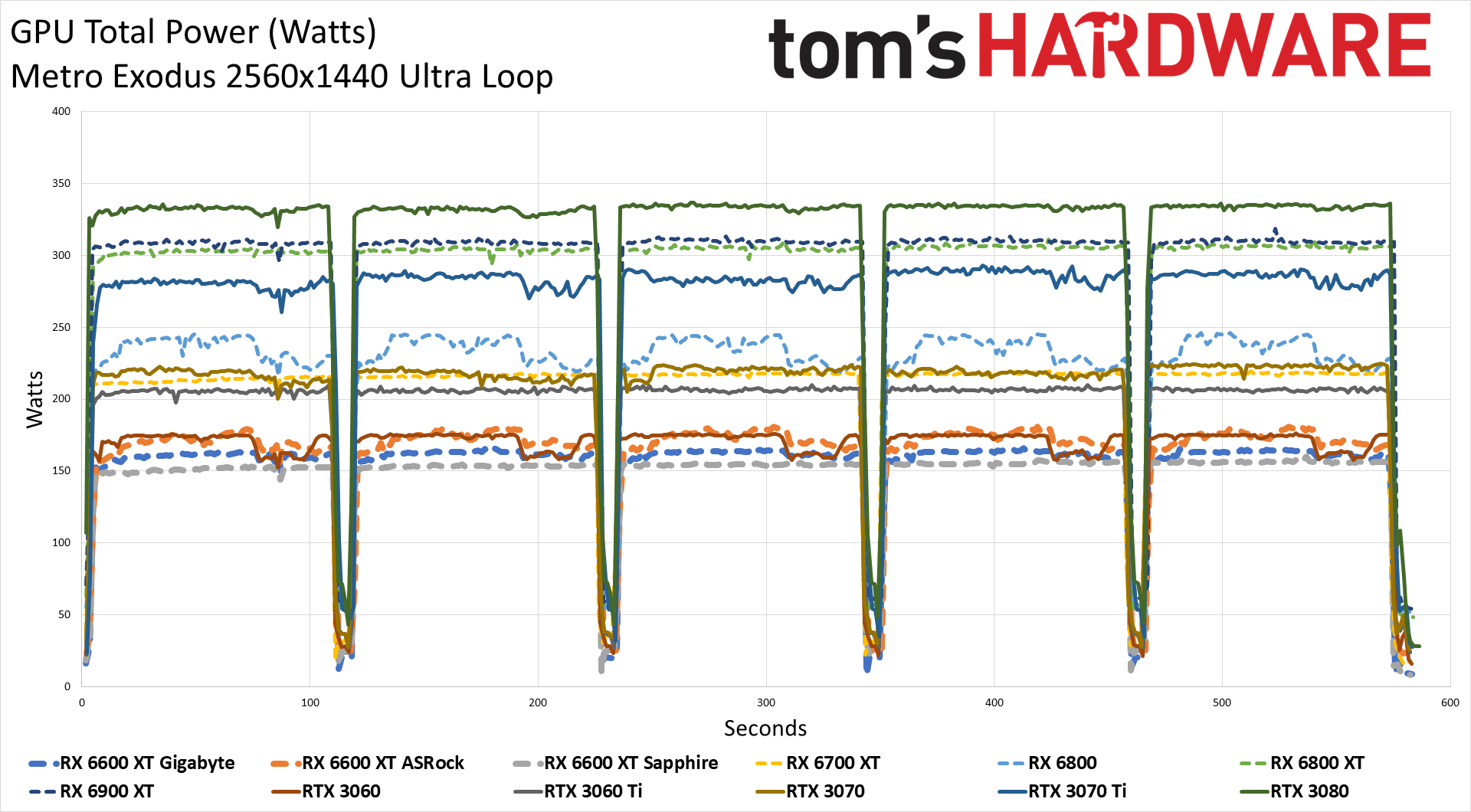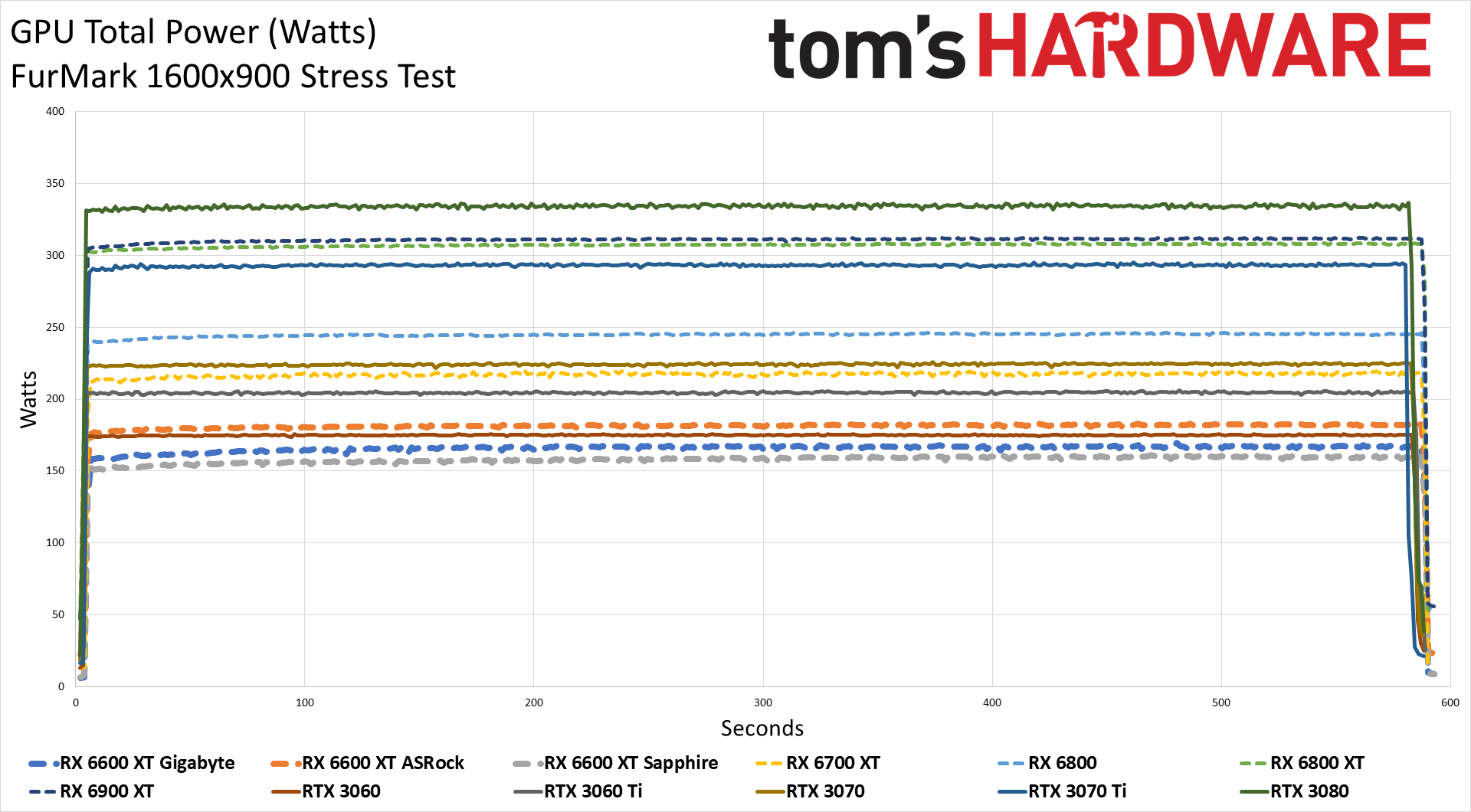Why you can trust Tom's Hardware
We've run our normal suite of Powenetics testing to check the GPU power consumption and other aspects of the cards. We used Metro Exodus at 1440p ultra and FurMark stress test at 900p for these results. The difference between the Gigabyte Eagle and the other two RX 6600 XT cards are more pronounced here than in our gaming benchmarks, and anyone concerned with noise levels will want to pay attention. Let's start with power.




The Gigabyte Eagle occupied the middle ground between the Sapphire Pulse and ASRock Phantom. It's pretty close to AMD's official 160W TDP, but ended up using just a bit more power than that — 166W in FurMark and 162W in Metro Exodus, not that 5W or less really matters. Most likely, the VRMs and power circuitry differences on the cards account for the minor differences in power use.




Average clock speeds on the Gigabyte card are basically tied with the Sapphire Pulse in Metro but slightly lower in FurMark. We put more weight on the gaming result, however, as FurMark can cause cards to behave a bit differently — some throttle more based on firmware settings, others ramp up fan speeds more to cope with the added power, etc.




This is where things become more problematic for the Gigabyte Eagle. While the core temperature was lower than the Sapphire card in FurMark, by 2C, and none of the RX 6600 XT cards ran particularly hot at a maximum of 70C (21C ambient), the Gigabyte card ran 2C hotter in the gaming test. But that's only the first part of the story, as temperatures and fan speeds are directly linked.




And here's the real problem. The smaller fans on the Gigabyte Eagle, combined with a relatively lightweight heatsink, ultimately required substantially higher RPMs to keep the card from overheating. Where the ASRock and Sapphire cards both land around 1300 RPMs in Metro and FurMark (give or take), the Gigabyte card runs the fans at over 2100 RPM. As you'd expect, that results in more noise, and the difference is clearly audible when using the cards — though even the Gigabyte card doesn't get particularly loud compared to extreme GPUs that can draw 350W or more in power.
We measured noise levels using an SPL meter, at a distance of 15cm. That focuses the microphone on the GPU fan noise rather than other sources like case or CPU fans. Ambient noise levels for testing were 33 dBA, and like most other modern GPUs, the fans on the Gigabyte card will stop spinning when GPU temperature falls below about 55C. Interestingly, where the ASRock card fully halts the fans between loops in the Metro benchmark, and the Sapphire card dips down to under 1000 RPM, the Gigabyte card takes longer to return to cooler GPU temperatures and as a result the fan only dipped slightly below 2000 RPMs. While actively playing games, the fans stabilize at around 2200–2300 RPM.
Fan noise for the Gigabyte Eagle was 44.4 dBA while gaming, about 7dB louder than the ASRock Phantom and Sapphire Pulse. Again, that's not incredibly loud — RTX 3070 Ti and above tend to land at 50 dB or more — but it's clearly more audible than the other two cards. If you're hoping to build a near-silent gaming PC, we definitely recommend the Sapphire as a better option, which also generally cools better and runs just as fast, for the same nominal price.
Get Tom's Hardware's best news and in-depth reviews, straight to your inbox.
The fan speed as a percentage was 54% on the Gigabyte card. Just to see how bad things might get (e.g., in a hotter testing environment), we set a static fan speed of 75% as well. Once we did that, the Eagle noise level was 62.1 dB, compared to 60.0 dB on the ASRock Phantom and 54.1 dB on the Sapphire Pulse. We don't expect these cards to normally get hot enough to require such fan speeds, but it's yet another point in favor of the Sapphire card.
MORE: Best Graphics Cards
MORE: GPU Benchmarks and Hierarchy
MORE: All Graphics Content
Current page: Power, Temps, Fan Speed, and Noise of Gigabyte Radeon RX 6600 XT Eagle
Prev Page Gaming Performance of Gigabyte Radeon RX 6600 XT Eagle Next Page Bottom Line
Jarred Walton is a senior editor at Tom's Hardware focusing on everything GPU. He has been working as a tech journalist since 2004, writing for AnandTech, Maximum PC, and PC Gamer. From the first S3 Virge '3D decelerators' to today's GPUs, Jarred keeps up with all the latest graphics trends and is the one to ask about game performance.
-
watzupken I am glad at least it doesn't explode. In any case, I feel the cutback is to be expected given that the Eagle series is Gigabyte's entry level model.Reply -
artk2219 Replywatzupken said:I am glad at least it doesn't explode. In any case, I feel the cutback is to be expected given that the Eagle series is Gigabyte's entry level model.
I agree some compromises are expected with entry level models, but the crazy thing is they didn't have to. I can't see the build cost on that longer triple fan model being any cheaper than some of the shorter dual fans models that are available. Eh who knows maybe they had a bunch of those fans, or could source them super cheaply, still doesn't explain the long heatsink or extra plastic etc on the card. -
Sleepy_Hollowed Something about JD and Turk screaming “Eagle”.Reply
in all seriousness, wow, this is truly budget in every sense of the word, it could be worse, but wow.
reminds me of my first blower card, GTX 660, and how loud and hot it ran (this was an oem design on an Alienware system). -
Findecanor Reply
Every large computer brand produces faulty hardware or software sooner or later.watzupken said:I am glad at least it doesn't explode.
The difference, which matters is in how they treat the issue — and the customers affected by it.
This was Gigabyte's biggest failure with the PSU. -
watzupken Reply
This I totally agree. I am not upset with failing products from Gigabyte. I am upset with the way they handle the issue. And considering this may be a potential fire hazard, or may end up killing something in the computer (where warranty gets void), it is highly irresponsible of Gigabyte to delay a recall and try to blame it on reviewers. Worst of all, they are bundling these PSU with GPUs despite knowing almost a year back of the issue. This just shows they don't care. Anyway, no more Gigabyte products for me after 2 decades of supporting them by buying their motherboards.Findecanor said:Every large computer brand produces faulty hardware or software sooner or later.
The difference, which matters is in how they treat the issue — and the customers affected by it.
This was Gigabyte's biggest failure with the PSU.
Back to the topic of this GPU.